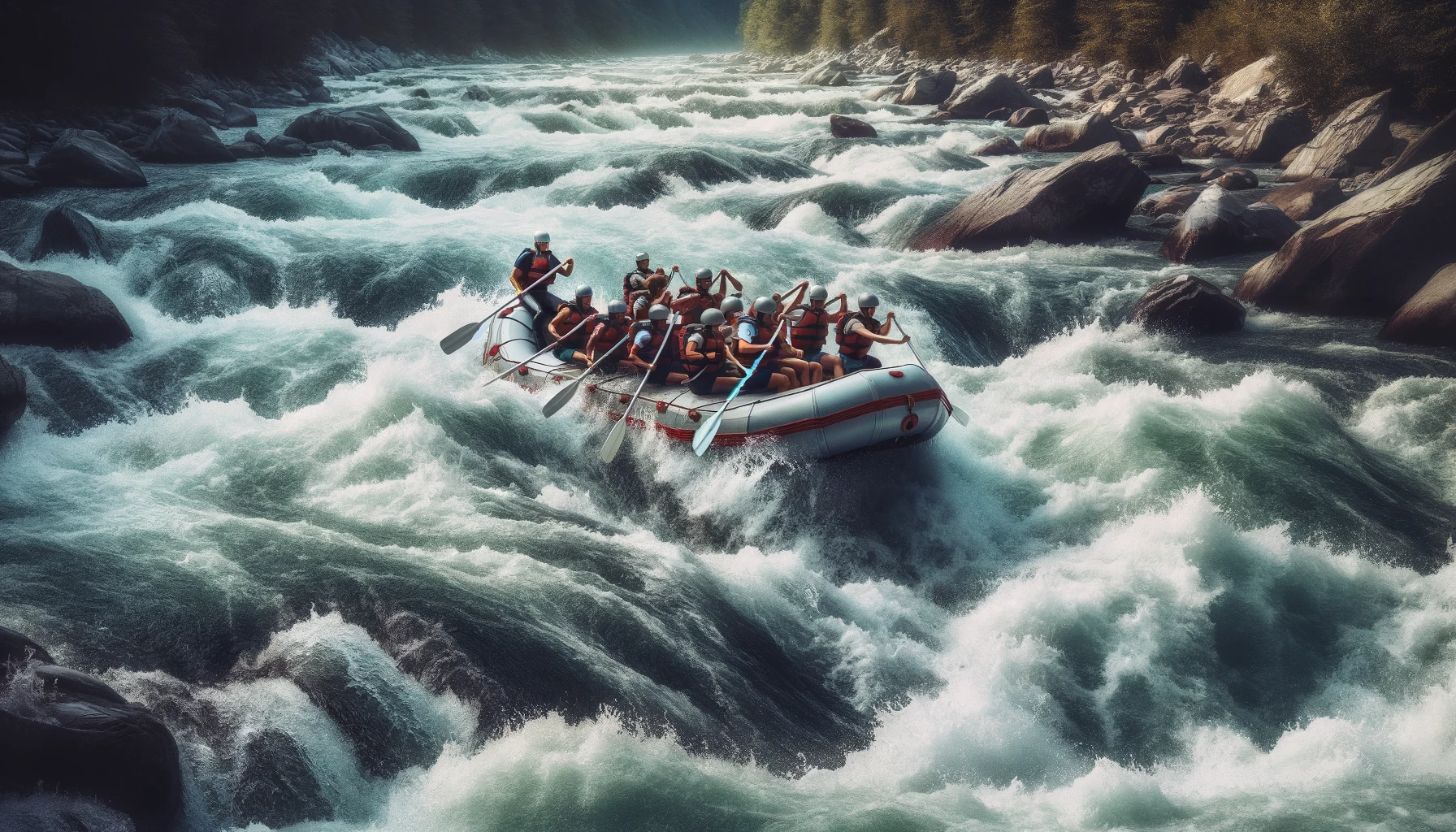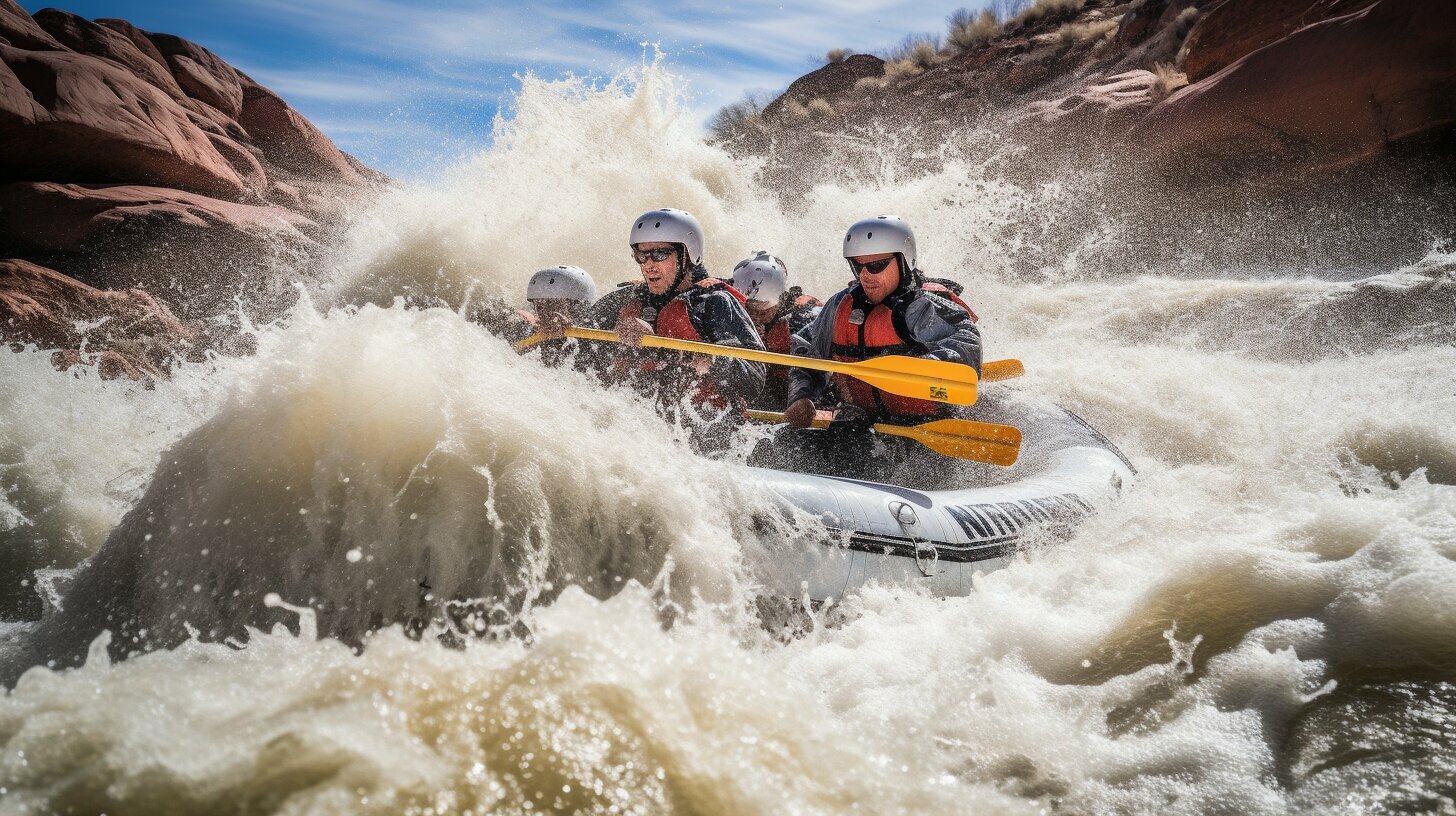If you’re looking for a fun and effective way to get fit, consider kayaking. With its low-impact yet challenging movements, kayaking can help you tone your body, increase your endurance, and improve your overall health and well-being. Whether you’re a seasoned kayaker or a beginner, kayaking can offer a rewarding and fulfilling fitness routine.
As you paddle through the water, you’ll engage your core, legs, and upper body muscles, providing a full-body workout that can help you build muscle strength and increase your cardiovascular endurance. Kayaking also offers mental benefits, such as reducing stress levels and improving mood.
In this article, we’ll explore the various benefits of kayaking for fitness, provide tips on incorporating kayaking into your fitness routine, and offer specific kayaking exercises for fitness. You’ll also learn about kayaking for weight loss, important safety considerations, and how to choose the right kayak for your needs.
Key Takeaways
- Kayaking is a low-impact yet challenging form of exercise that can help you tone your body and increase your endurance.
- Kayaking provides mental benefits, such as reducing stress levels and improving mood.
- Through this article, you’ll learn how to incorporate kayaking into your fitness routine, perform specific kayaking exercises for fitness, and explore the various benefits of kayaking for weight loss and overall health.
The Benefits of Kayaking for Fitness
Kayaking is more than just a fun water sport; it offers numerous health benefits that make it a great option for those looking to improve their fitness. Incorporating kayaking into your fitness routine can have positive impacts on both physical and mental health. Here are some of the top benefits of kayaking for fitness:
| Benefit | Description |
|---|---|
| Kayaking Improves Cardiovascular Health | Kayaking involves paddling, which is a great form of aerobic exercise that can help improve cardiovascular health. Regular kayaking sessions can help strengthen the heart, lower blood pressure, and even reduce the risk of heart disease. |
| Kayaking Builds Muscle Strength | Kayaking is a full-body workout that can help build muscle strength, especially in the arms, shoulders, and core. By using paddling strokes, you can work these muscles and improve your overall strength. |
| Kayaking Enhances Endurance | Kayaking is also a great way to improve endurance. As you paddle, your body is working to maintain speed and resistance, which can build endurance and help you go longer and farther during each session. |
| Kayaking Benefits Mental Health | The benefits of kayaking extend beyond physical fitness; it can also be great for mental health. The peacefulness of being on the water, the fresh air, and the opportunity to disconnect from technology and distractions can all contribute to reduced stress and improved mental well-being. |
By incorporating kayaking into your fitness routine, you can experience these benefits and more. Whether you’re a beginner or an experienced kayaker, it’s never too late to start using this water sport as a way to improve your overall health.
Disclosure: When you buy through links on our site, we may earn an affiliate commission.
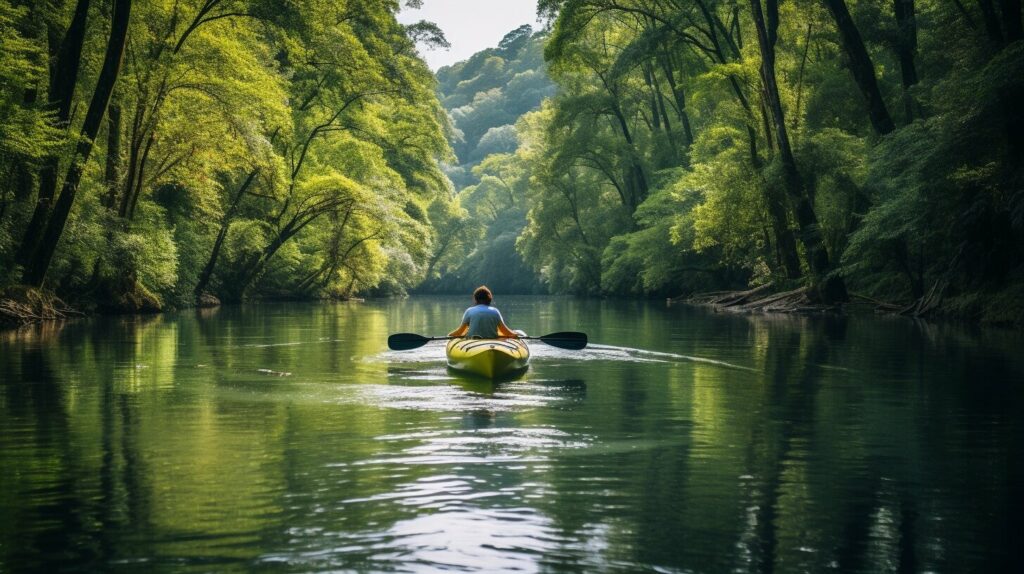
Incorporating Kayaking into Your Fitness Routine
Kayaking can be an excellent addition to your fitness routine, providing a full-body workout while enjoying the great outdoors. Here are some tips to help you incorporate kayaking into your fitness routine:
- Set goals: Determine what you want to achieve through kayaking, whether it’s building endurance, toning muscles, or just enjoying nature.
- Find the right equipment: Invest in a quality kayak and paddle that fit your body and skill level. Consider renting equipment or taking lessons before buying your own.
- Plan your sessions: Schedule kayaking sessions regularly and plan your routes according to your fitness goals. Start with shorter sessions and gradually increase their duration and intensity.
- Warm-up: Always warm up your muscles and stretch before kayaking to avoid injury and prepare your body for the activity.
- Vary your routine: Mix up your kayaking exercises, incorporating interval training, sprints, and endurance paddling to challenge your body and avoid monotony.
By following these tips, you can create a kayaking fitness routine that is enjoyable, effective, and sustainable.
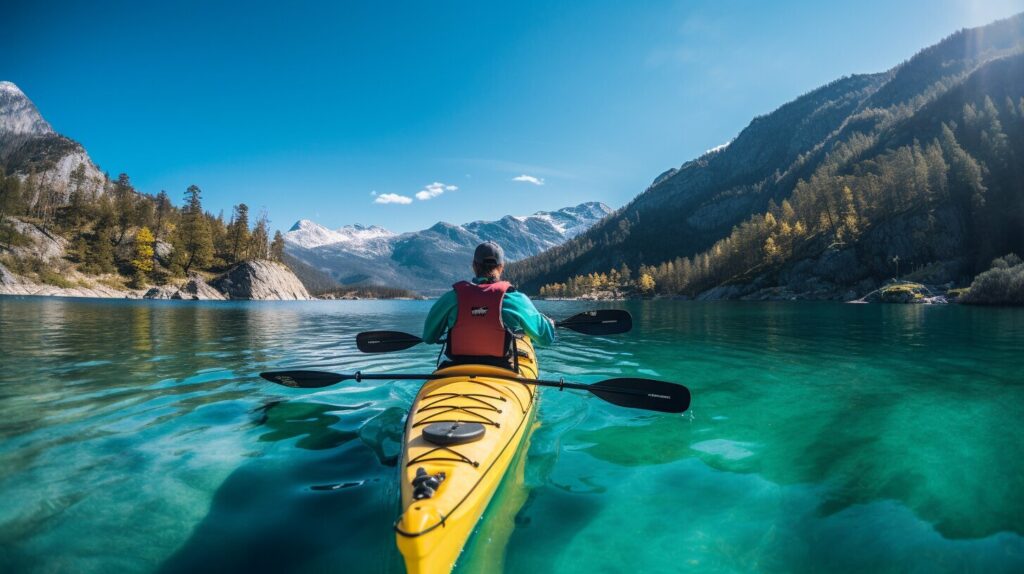
Kayaking Exercises for Fitness
Kayaking can be a fun and effective way to improve your fitness level. Here are some kayaking exercises that can help tone your muscles and increase your endurance:
| Exercise | Description |
|---|---|
| Paddling drills | Practice different paddling techniques, such as forward strokes, reverse strokes, and side strokes, to build upper body strength and improve paddling efficiency. |
| Core strengthening movements | Engage your core muscles by rotating your torso with each paddle stroke or by performing exercises such as Russian twists or seated leg raises. |
| Interval training techniques | Alternate between high-intensity paddling and low-intensity paddling to improve cardiovascular health and burn calories. |
It’s important to start with easy exercises and progress slowly to avoid injury. Always warm up before kayaking and stretch after your workout to prevent muscle soreness.
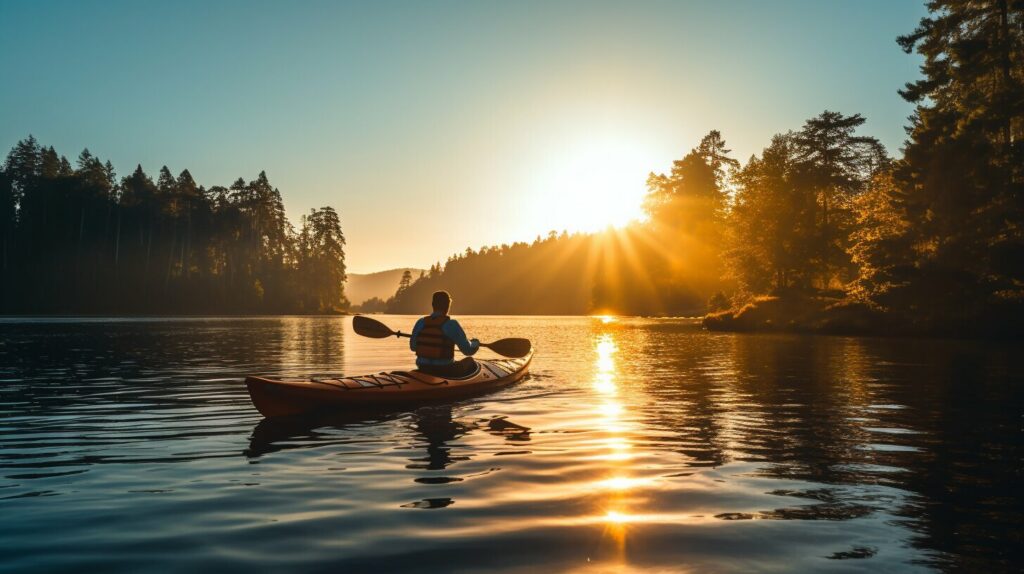
“Kayaking workouts can help target your upper body muscles, improve your cardiovascular health, and burn calories.”
Try This Exercise: Kayak Intervals
- Warm up by paddling at a moderate speed for 5-10 minutes.
- Paddle at a high-intensity for 30 seconds to 1 minute.
- Recover by paddling at a low-intensity for 1-2 minutes.
- Repeat the high-intensity and low-intensity intervals for 10-20 minutes.
- Cool down by paddling at a low intensity for 5-10 minutes.
Remember to listen to your body and adjust the intensity and duration of your kayaking exercises as needed. Consistency is key to achieving your fitness goals with kayaking.
Kayaking for Weight Loss
Are you looking for a fun and effective way to shed some pounds? Kayaking can be an excellent option for weight loss. Not only is it a low-impact activity that is easy on the joints, but it also burns a significant amount of calories.
A person weighing 125 pounds can burn up to 283 calories per hour of kayaking. If you weigh 155 pounds, you can burn up to 352 calories per hour, and if you weigh 185 pounds, you can burn up to 420 calories per hour. These calorie-burning figures can certainly add up over time and lead to weight loss.
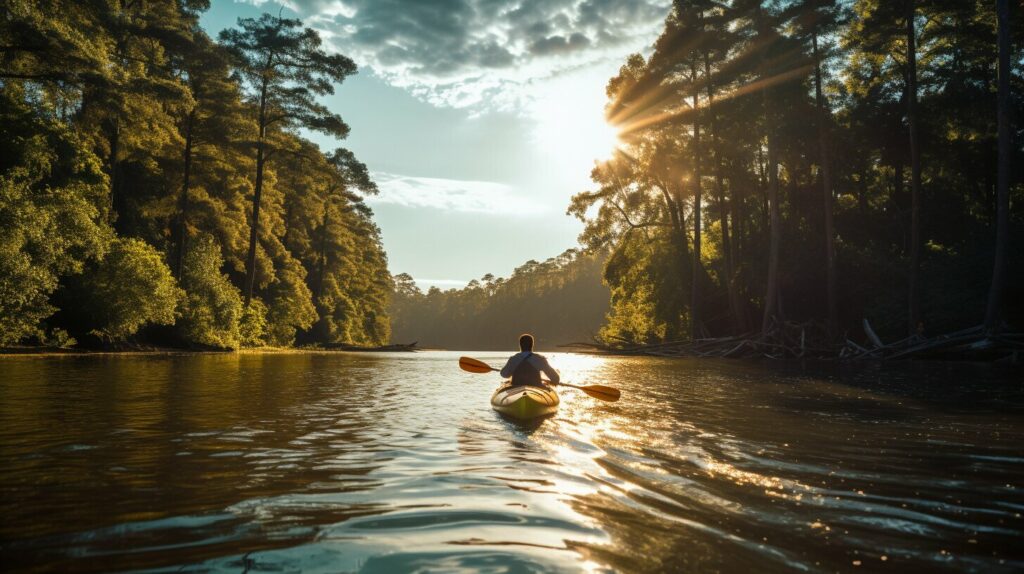
However, it’s important to note that the number of calories burned while kayaking depends on various factors, such as your speed, the intensity of your paddling, and the type of kayak used. Still, kayaking as a form of aerobic exercise can be an effective tool for achieving weight loss goals.
Incorporating kayaking into your overall fitness routine and maintaining a healthy diet can further contribute to weight loss. Remember to drink plenty of water before, during, and after kayaking sessions to stay hydrated and energized.
So, if you’re looking for a fun and unique way to shed some pounds, consider giving kayaking a try. You may just find yourself enjoying the journey towards a healthier you.
Safety Considerations for Kayaking Fitness
If you’re new to kayaking for fitness, it’s important to take some safety precautions before you hit the water. Kayaking is generally a safe activity, but accidents can happen, so it’s crucial to be prepared and take necessary safety measures. Here are some tips to keep in mind:
Wear a Life Jacket
A life jacket is a must-have when kayaking for fitness. Make sure to wear it at all times, even if you’re a strong swimmer. The life jacket should fit properly and be rated for your weight. Don’t rely on inflatable life jackets, as they may not inflate properly or in time.
Check Weather Conditions
Before you head out, check the weather forecast. Avoid kayaking in high winds, thunderstorms, or heavy rain. If you see signs of bad weather while you’re on the water, head back to shore immediately.
Be Aware of Potential Hazards
Be mindful of obstacles such as rocks, fallen trees, or other hazards that may be lurking beneath the water’s surface. Keep an eye out for other boats and watercraft, and avoid areas with strong currents or large waves.
Get Proper Training and Supervision
If you’re new to kayaking, consider taking a class or working with a certified instructor to learn the basics. They can teach you proper techniques for paddling and maneuvering your kayak, as well as safety tips. Always kayak with a buddy or group, especially if you’re a beginner.
Bring Necessary Gear
Make sure to bring the necessary gear with you, including a paddle, whistle, and light, if kayaking at night. A dry bag or waterproof case can keep your valuables safe and dry. Don’t forget sun protection, like a hat, sunglasses, and sunscreen.
By following these safety tips, you can enjoy kayaking for fitness while minimizing any potential risks. Always prioritize safety and be prepared before you set out on the water.
Exploring Nature While Getting Fit
Kayaking for fitness not only provides physical benefits but also allows you to immerse yourself in nature and reap the mental and emotional rewards of being outdoors. The calming effect of the water and the beauty of your surroundings can help reduce stress and promote a sense of well-being.
As you paddle through scenic locations, you’ll also be able to explore different ecosystems and wildlife. Keep an eye out for birds, fish, and other creatures that call the water their home. Kayaking can be a great way to connect with nature, especially if you live in an urban environment.
Take advantage of the opportunity to slow down, breathe in fresh air, and appreciate the natural world around you. It can be a great way to clear your mind and find peace in the present moment.
So, grab your kayak and paddles, and head out to explore the great outdoors while getting fit with kayaking.
Choosing the Right Kayak for Fitness
When it comes to kayaking for fitness, choosing the right kayak is essential to ensure a comfortable and effective workout. Here are some factors to consider:
| Factor | Considerations |
|---|---|
| Kayak Type | Recreational kayaks are suitable for beginners and casual paddlers, while touring kayaks are designed for longer distances and higher speeds. Sit-on-top kayaks are more stable, making them a good choice for fitness activities such as yoga or fishing. |
| Kayak Size | The size of the kayak should be chosen according to the paddler’s height, weight, and skill level. A kayak that is too small or too big can cause discomfort and instability, affecting the workout. |
| Kayak Stability | Stability is important for fitness activities, as it provides a solid base for performing exercises such as balance training or paddling drills. A kayak with good stability helps maintain proper form and reduces the risk of injury. |
| Fitness Goals | The choice of kayak should align with the paddler’s fitness goals. For instance, those looking to focus on upper body strength may prefer a kayak with a narrow width and longer length, while those aiming for a full-body workout may prefer a wider kayak with a stable base. |
Remember that comfort is key to enjoying a kayak fitness routine. Make sure to choose a kayak with proper seating, adjustable footrests, and ample storage space for equipment and snacks. Additionally, consider renting a kayak or taking lessons before purchasing one to test out different options and find the perfect fit.
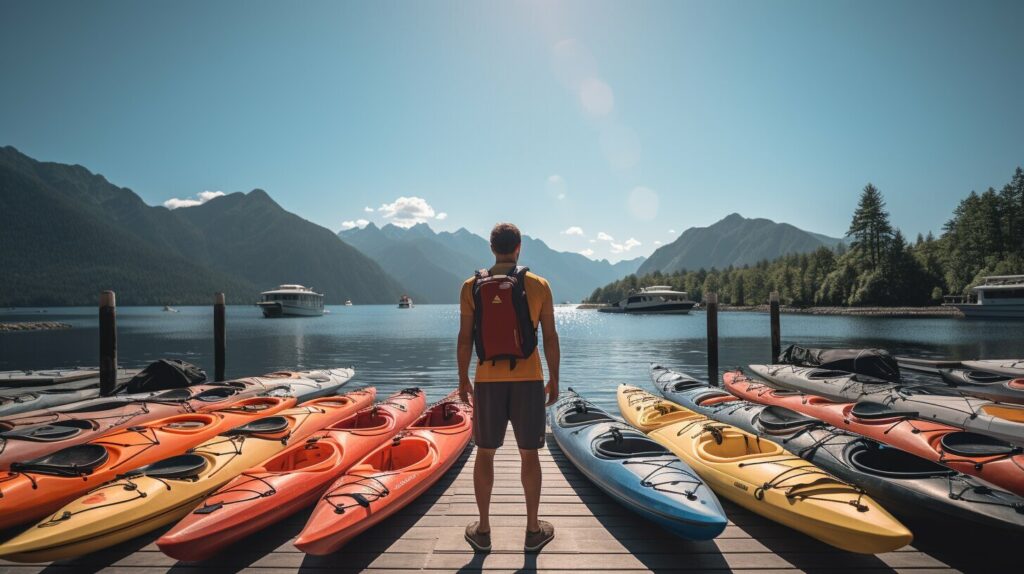
Exploring Different Kayaking Locations for Fitness
When it comes to kayaking for fitness, there are many different locations to consider. From rivers to lakes to the ocean, each location offers its own unique challenges and benefits.
If you’re just starting out with kayaking, you may want to begin with calm, flatwater locations such as a lake. This will allow you to focus on developing your technique and building endurance without the added challenge of rougher waters or strong currents.
As you become more experienced and confident, you can start exploring other locations such as rivers and coastal areas. These locations provide a more dynamic environment that can challenge your balance, coordination, and endurance in new ways.
Indoor kayaking facilities are another option to consider. These facilities offer the ability to practice kayaking in a controlled environment, which can be particularly helpful during inclement weather or when time is limited.
Whether you choose to kayak in calm lakes or challenging rivers, kayaking for fitness is a great way to explore new locations and enjoy the beauty of nature. So, pick a location that appeals to you, grab your kayak, and get ready to experience the power of kayaking for fitness.
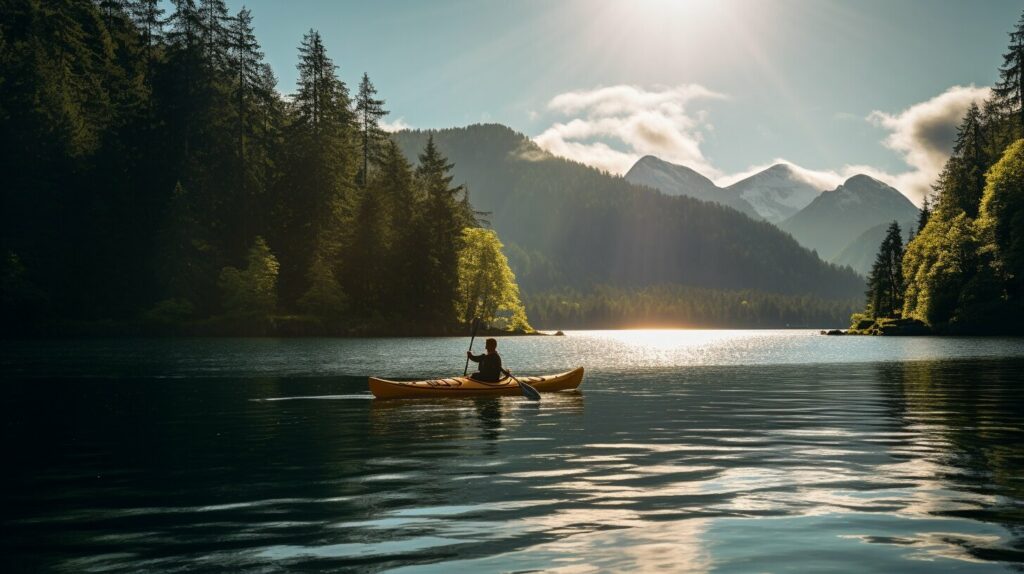
Tips for Improving Kayaking Technique
Kayaking is a fantastic way to get fit, but to make the most of your workouts, it’s essential to maintain good technique. Here are some tips to help you improve your kayaking form:
- Positioning the paddle: When holding your paddle, make sure to keep your arms straight and your hands shoulder-width apart on the paddle shaft. Keep one hand on top of the paddle and the other hand on the bottom, ensuring the blade is in the water at the correct angle.
- Efficient strokes: Your strokes should be long and smooth, focusing on pulling through the water with your core muscles. Avoid using just your arms, and instead engage your back and abdominal muscles to help propel your kayak forward.
- Body posture: Sit up straight in your kayak, keeping your shoulders relaxed and your core engaged. A good posture will help you maintain your balance and reduce the risk of injury.
By focusing on your technique, you can improve your kayaking efficiency and avoid unnecessary strain on your body. Remember to practice regularly and seek guidance from a professional if you’re unsure about any aspects of your kayaking form.

Staying Motivated on Your Kayaking Fitness Journey
Starting your kayaking fitness journey is a great step towards a healthier you. However, staying motivated can be challenging, especially when you have to overcome obstacles such as bad weather or busy schedules. Here are some tips to help you stay motivated:
- Set achievable goals: Start with small, achievable goals and gradually increase the intensity and duration of your kayaking sessions. Celebrate your achievements along the way and keep track of your progress.
- Find a partner: Kayaking with a partner can be more fun and motivating. Find someone who shares your fitness goals and schedule regular kayaking sessions together.
- Join a community: Joining a local kayaking community can help you meet like-minded individuals and participate in group kayaking events. Check out sites like Meetup.com or local paddling clubs to find a kayaking group near you.
- Try something new: If you’re getting bored with your usual kayaking routine, try something new like exploring a new location or trying a different type of kayak. Mixing things up can help keep you motivated and engaged.
- Participate in kayaking events: Participating in kayaking races or events can provide a great source of motivation. Sign up for a local race or challenge yourself with a longer distance kayaking journey.
Remember, consistency is key when it comes to achieving your fitness goals. Don’t get discouraged if progress is slow, and don’t be too hard on yourself if you miss a kayaking session. Each kayaking session is an opportunity to improve and get closer to your fitness goals.

“The only bad workout is the one that didn’t happen.” – Anonymous
Conclusion
Not only does kayaking provide a full-body workout, but it also offers mental and emotional benefits by allowing you to connect with nature.
By incorporating kayaking into your fitness routine, you can increase your cardiovascular health, build muscle strength, and improve your overall endurance. With kayaking, weight loss goals can also be achieved by burning calories and maintaining a healthy diet.
To make the most of your kayaking fitness routine, consider incorporating specific kayaking exercises and improving your technique. Finding the right kayak, location, and setting achievable goals can also help keep you motivated on your health journey.
Remember, consistency is key when it comes to achieving your fitness goals. So embrace kayaking as a holistic fitness experience and begin your journey to unlock your full potential today!
FAQ
Q: Is kayaking a good workout for fitness?
A: Yes, kayaking is an excellent workout for fitness. It helps in toning the body, improving cardiovascular health, building muscle strength, and increasing endurance.
Q: How can I incorporate kayaking into my fitness routine?
A: To incorporate kayaking into your fitness routine, you can set goals, find the right equipment, plan kayaking sessions, and warm up before paddling. It’s important to start slowly and gradually increase intensity and duration.
Q: What are some kayaking exercises for fitness?
A: Some kayaking exercises for fitness include paddling drills, core strengthening movements, and interval training techniques. These exercises target various muscle groups and help improve overall fitness levels.
Q: Can kayaking help with weight loss?
A: Yes, kayaking can contribute to weight loss. It is a form of aerobic exercise that helps burn calories. However, it’s important to maintain a healthy diet alongside kayaking for weight loss goals.
Q: What safety considerations should I keep in mind for kayaking fitness?
A: When engaging in kayaking for fitness, it’s important to prioritize safety. Always wear a life jacket, check weather conditions, and be aware of potential hazards. Proper training and supervision are especially important for beginners.
Q: How can kayaking for fitness connect with nature?
A: Kayaking for fitness allows you to enjoy nature while engaging in physical activity. It offers mental and emotional benefits by providing a sense of peace and connection with the natural environment.
Q: How do I choose the right kayak for fitness?
A: When choosing a kayak for fitness, consider factors such as kayak type, size, and stability. It’s important to select a kayak that aligns with your fitness goals and experience level, ensuring comfort and proper fitting.
Q: What are some different kayaking locations for fitness?
A: There are various kayaking locations suitable for fitness activities, including rivers, lakes, coastal areas, and even indoor kayaking facilities. Each location offers different challenges and benefits for your kayaking fitness routine.
Q: How can I improve my kayaking technique for better fitness results?
A: To improve kayaking technique, focus on paddle positioning, stroke efficiency, and body posture. Proper technique and form will enhance your kayaking experience and maximize fitness benefits.
Q: How can I stay motivated on my kayaking fitness journey?
A: Staying motivated on your kayaking fitness journey can be achieved by setting achievable goals, tracking progress, and finding motivators such as community kayaking groups or participating in kayak races. Remember the long-term benefits of consistent kayaking practice for overall health and well-being.


